Main Content
Article
Jewish Heritage Initiative

The Indiana Jewish Heritage Initiative is funded through the generous support of the Midwest Regional Office of the National Park Service

In a quest to continue its public recognition and preservation of Indiana’s history and historic sites and structures, the Division of Historic Preservation and Archaeology, in partnership with the Midwest Regional Office of the National Park Service, has intensified its commitment to the interpretation, preservation and representation of the Hoosier State’s historic Jewish communities. To better understand this nearly-forgotten Indiana history, the DHPA has created the Indiana Jewish Heritage Initiative, a project designed to encourage the preservation of remaining Jewish cultural sites and with them the history of these waning communities.
The Indiana Jewish Heritage Initiative, funded through the generous support of the National Park Service, promotes the conservation of Indiana's Jewish cultural resources through the identification, preservation, interpretation, and recognition of sites representative of historic Hoosier Jewish communities. To do this, the Division of Historic Preservation and Archaeology has undertaken in-depth research of the state’s Jewish history to compile a list of potentially historic sites including structures such as commercial buildings, houses and cemeteries. The DHPA, along with its network of local and county historians, Jewish federations, synagogues, historical societies, and descendants, will investigate these sites, revealing the often overlooked and underrepresented histories that accompany both standing and former sites and structures.
The list below containd sites and structures with significance to Jewish heritage with red highlighting. Select a county to view the history. (NOTE: Many county histories are not available at this time but will be added in the future as our research progresses)
- Allen County
Fort Wayne, the county seat of Allen County developed from a fort founded in 1794 fort. Early pioneers were attracted to Fort Wayne by the profitable fur trade. The first known Jewish man in the area was John Jacob Hays, who moved to Cahokia on the Mississippi in 1793 and was appointed an Indian agent at Fort Wayne.
Construction of the Wabash & Erie Canal in the 1830s fostered further commercial possibilities and caused a great influx of immigrants to the growing community. Jewish immigrants from Germany began arriving in Fort Wayne in the 1830s. Although no Jews are listed in the 1840 census, Sigmund Redelsheimer had arrived the year before and soon established a general store on Columbia Street in partnership with Abraham Oppenheimer. Redelsheimer would help found the first congregation. In 1844, Isaac Lauferty arrived to establish a clothing store, and later a private bank. In 1875, the city directory lists Lauferty as a banker and broker.
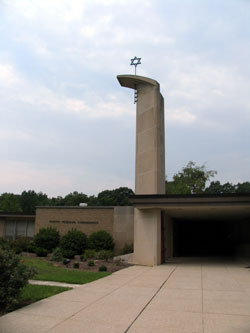
Congregation Acduth Vesholom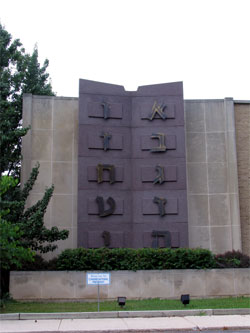
Congregation Acduth Vesholom - Scroll - Bartholomew County
In September 1861 The Israelite, a Cincinnati-based Jewish weekly publication, reported that Columbus, Indiana Jews, though “few in number,” “have with a spirit of perseverance and liberality worthy of emulation, organized a new congregation under the title of Chisak Emuna.” Members elected Reverend Simon Benmann as minister as well as a president, vice president, treasurer, secretary, and three trustees. For the next 150 years, the Columbus Jewry continued to worship together despite a small membership and organizational changes.
The city of Columbus boasts the largest recorded population of Jews in Bartholomew County and serves as the county seat. Since the nineteenth century Bartholomew County residents have relied on a largely agricultural and manufacturing based economy, yet, very few Jews farmed. Instead they usually leased their land to others to do so. In the mid-nineteenth century, Columbus, like most Indiana cities, attracted Jewish families who settled and sustained their livelihoods through wool mills, retail stores, and services.
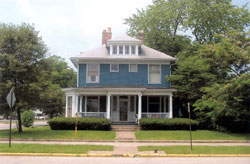
Brunswick House - Cass County
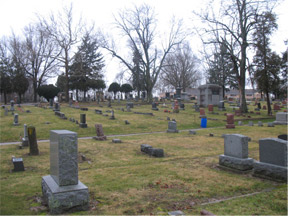
Mount Hope CemeteryThe city of Logansport developed in the fertile land right at the juncture of the Wabash and Eel Rivers. Local legend maintains that in 1827 a shooting contest took place between Hugh McKeen, an early settler, and Colonel John B. Duret for the right to name the new city. Duret won and chose the name Logan’s Port after Shawnee Chief Logan, who died in the War of 1812 fighting with the Americans against the British. The name was eventually modified to Logansport and the city was incorporated in 1837-38. The city’s location along the rivers, coupled with the construction of the Wabash and Erie Canal, and followed by the construction of the railroad through the town, ensured that Logansport would continue to grow. By 1850 the city boasted a population of 2,251 people. In 1870, the city had grown to a population of 8,950, and the population peaked in 1920 at 21,626. A fairly large Jewish community developed in Logansport early in the city’s history, with the first known family settling in the late 1850s.
Read the entire paper about Cass County’s Jewish Population.
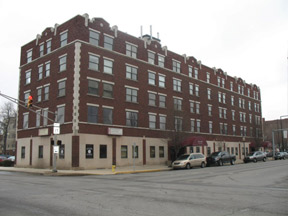
Barnes Hotel in Logansport - Delaware County
Founded in 1827, Muncie, the county seat of Delaware County, grew slowly until the discovery of natural gas in 1886, when an economic boom ensued and the population increased from a few thousand inhabitants to tens of thousands. By the early twentieth century, depletion of the natural gas slowed growth, but Muncie’s central location, industrial capacity, and large workforce helped it to remain viable throughout the next century with various industries. Besides Ball canning jars and Ball State University, Muncie may be best known as “Middletown,” the typical American city that sociologists Robert and Helen Lynd studied and reported upon in the 1920s and 30s in an effort to understand life in middle America.
Jews were a small, but significant element in the story of Muncie’s development. Jews were present in Muncie at least as early as the 1850s, when brothers Lipman and Henry Marks opened a dry goods store in Muncie. The Jewish population of Muncie, even at its height, never exceeded 200 people. With an extremely small population, it was impossible for the Jewish community to support more than one temple, let alone a kosher butcher. Nevertheless, their impact and influence on the greater community as a whole was disproportionately greater then their numbers. By the turn of the century, Jewish entrepreneurs operated a large proportion of downtown businesses.
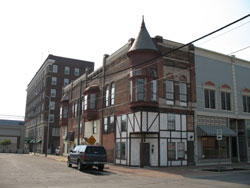
Ruberns-Eichel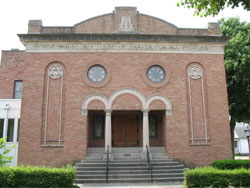
Temple Bethel-El - Elkhart County
Elkhart County was one of the first areas settled in Northern Indiana, as early as 1826. The city of Goshen serves as the county seat. While the date of the first Jewish person into the county is unclear, a congregation was meeting in the town of Goshen before 1877.
Like most of the other congregations in the state, Congregation Shearith Israel started off by worshiping in individuals’ homes until a first permanent building was purchased. Their first structure, built in 1859 as a Baptist church, was purchased in 1876. They then purchased land in 1877 at Oak Ridge Cemetery for the burial of the dead; the section was known as Shearith Israel Cemetery.
After a permanent building and the cemetery purchase, the congregation started their Sabbath School in 1879. Around 1878, it is estimated that Goshen had about 125 Jews; this number hit an all time high in 1907 with 139 individuals, but by 1927 it was reduced to 51.2 Some of the business owners included Louis Simon who owned L. Simon Clothiers, Aaron Cohen Clothier, Bernstein’s Cigars, Jacob Frankenstein and Edward Frankenstein, Harris Frankenstein, Freddie Simon, Sol Meyer; manufacturer of cigars, Abraham Kaatz, local tailor in business with Herman Goldstein, and Daniel Oppenheim.
A 1943 article concerning the death of Rabbi Harris Weinstein states that there were fifteen Jewish families living in Goshen. Temple Sharis Israel had been abandoned in 1932, but Weinstein still officiated at weddings and deaths. Weinstein was born in Lithuania in 1859. He came to America in 1880, living for some time in New York and Evansville, Indiana before moving to Goshen. He was active in the Mason’s organization.
Rolling Prairie, platted in 1853 was the site of Camp Moshava, established on thirteen acres by Chicago Mizrahi, a Religious Zionist Movement. The camp was used from 1939-1955.
Around 1878, it is estimated that Goshen had about 125 Jews; this number hit an all time high in 1907 with 139 individuals. By 1927 it was reduced to 51.2 Some of the business owners included Louis Simon who owned L. Simon Clothiers, Aaron Cohen Clothier, Bernstein’s Cigars, Jacob Frankenstein and Edward Frankenstein, Harris Frankenstein, Freddie Simon, Sol Meyer; manufacturer of cigars, Abraham Kaatz, local tailor in business with Herman Goldstein, and Daniel Oppenheim.
- Grant County
Marion, the county seat of Grant County was settled in 1826; it was organized in 1831. The original inhabitants of the area were the Miami Indians, but several battles and treaty negotiations ceded much of the land to the American government. Grant County has a strong Quaker history, who came in the 1820s and 1830s, drawn by the rich, fertile farmland. Natural gas was found in the county in 1887, stimulating growth, but this gas boom did not last for more than a decade. While there are several larger communities in Grant County (Converse, Fairmount, Fowlerton, Gas City, Jonesboro, Marion, Matthews, Swayzee, Sweetser, Upland and Van Buren), it was the city of Marion that attracted the majority of the Jewish population; a small community flourished in Gas City.
- Howard County
Kokomo, the county seat of Howard County, was laid out in 1844. The Wabash and Erie Canal brought an economic boom to the county. Most of the settlers were farmers; a great many of them were Quakers. Like many of the other counties in this area of Indiana, natural gas was found in 1886, leading to another economic growth.
While as early as 1845, Samuel Rosenthal settled and opened a store, the Jewish population never boomed and became a community until the twentieth century. At this time, Jews became members of the large community and eventually came together to promote their Jewish life.
- Huntington County
The earliest inhabitants of the county were the Miami Indians. Their existence in the county brought fur traders into the area. By 1804, the Quakers had established an agricultural school for the Miami. In 1834, Huntington County was created from a once larger Grant County. The development of the Wabash and Erie Canal through county in 1835 further encouraged settlers. Despite this early settlement, no significant Jewish community was ever established in the county.
David Marx came to Huntington County in 1874, where he met and married Amelia Levi. He started a clothing business with his brother-in-law Jacob, but by 1885 he operated the business alone (D. Marx and Son men’s clothing business). David served as a city councilman and was active in the Democratic Party. A small group of Orthodox Jews lived in the city (a 1903 article announced that they had rented a hall for services), but without a membership roster, finding their identities is difficult.
Jacob Brenn founded Huntington Laboratories, a chemical production company. Hy Goldberg, who worked for Huntington Laboratories and was active in the preservation of the natural environment.
- Jefferson County
Madison, Indiana sits on the Ohio River. It served as one of the important cities in the early development of Indiana. Its location on the river made it one of the central shipping locations in the state. One of the largest commodities trade were pigs, earning Madison the dubious title of “Porkopolis.”1 Despite this fact, Madison became a place for settlement by Jews.
One of the first families to arrive was Elias and Teresa Hilpp in 1847. They had lived in New Orleans and Louisville before settling in Madison. Also in that year, Aaron Marks from German settled in Madison. He worked as a peddler before coming to Madison, so when he arrived he had enough money to open a store. In 1849, a marriage between Ernestine Wehle and Max Abeles was performed in Madison, possibly the first Jewish marriage officiated by a Rabbi.
- Knox County
Vincennes, is the oldest town in Indiana, settled as early as 1763. Samuel Judah settles in Vincennes in 1818. He served in the Indiana State Legislature 1825-40; he was the Speaker of House of the 25th Assembly.
Adam Gimbel arrived in the United States from Bavaria in 1835. Working as a peddler, he traveled along the Mississippi and Ohio Rivers. In May 1842, he settled in Vincennes. He opened his Palace of Trade in 1842. Some of his siblings soon joined him, helping him open four stores, a wholesale liquor business, and major interest in the American Bank of Vincennes. Adam served as a member of the city council, 1842-1866. In 1866, Gimbel sold his interests in the business and moved to Philadelphia; other family members soon followed. Gimbel opened stores in Philadelphia (1894), New York (1910), and Pittsburgh (1925). In 1928 Saks Fifth Avenue became a Gimbel subsidiary.
The American Jewish Archives has notes that Congregation Hovas Hochim was in the county in 1931. A group of Polish Jews formed the congregation. Services were held at various rented location; elders conducted the service. Eventually, a grocery store was purchased, renovated and became the synagogue. Through deaths and relocation, the Jewish population dwindled and the congregation disbanded in the 1960s. Jewish interments occurred in the local Crown Hill Cemetery.
- Lake County
Lake County, located in the northwest corner of Indiana, was first explored by Jesuit priests in 1675. Lake County was officially organized into three townships in 1837. The northern third is heavily industrialized, with strong ties Chicago. On the other hand, the southern two thirds typifies much of rural Indiana with farms and rural communities. Because of the county’s topography, much of the early settlement occurred in the county’s central areas.
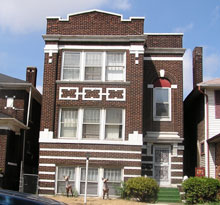
Milgram House, Gary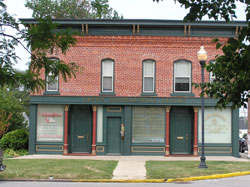
Winer Building, Crown Point - LaPorte County
La Porte County Jewish History LaPorte County, nestled in the Dunes Region of Northwest Indiana had its first white settlers beginning in the early 1830s. Both Michigan City and LaPorte grew as the most populated hamlets of the county. LaPorte grew due to Section 4 of LaPorte County’s Act of Incorporation, stating that county commission meetings were to be held near the center of the county, attracted residents and business to the center of the newly formed county. Michigan City would thrive due to economic benefits of being on Lake Michigan, but it would quickly be outclassed by Chicago’s larger port.
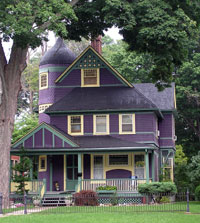
Henoch Residence
Fox Civic Auditorium - Madison County
Anderson is the county seat of Madison County was platted in 1823. Trader William Conner came into the area now known as Anderson before the 1820s. Introduction of internal improvements caused a growth in the population in 1837. The Central Canal, a branch of the Wabash and Erie Canal was to come through Anderson. The completion of the railroad in 1852 caused another population growth. In 1865, Anderson was incorporated as a city, with a population of nearly 1300 people. Moses Marks, an early Jewish businessman, came to Anderson sometime in the late 1840s or early 1850s.
Prior to the 1865 there were but a very few Jewish families residing in Anderson. These families included Louis Loeb, Joseph Stein, Louis Warner (a partner in Gates & Warner, clothing store), J. Obendofer, Jacob Warner, and Philip Obendofer. However, in 1870 several more families moved to Anderson.1
In 1887 natural gas was discovered in Anderson; by 1912 the natural gas ran out. Several factories moved out. The whole city slowed down. With its proximity to Muncie, Indiana a Muncie-Anderson Hadassah Chapter was formed.2 Several Jewish business owners operated in Anderson. Morthon Roth opened a ready to wear store, Ray Weiler operated Weiler’s Department Store, which was stated in Portland, Indiana by his father. In addition, a Mr. Ziegler operated a scrap business.
Footnotes
1 John Forkner and Byron Dyson, Historical Sketchers and Reminiscences of Madison County, IN (Logansport, Indiana: Wilson, Humphreys and Co, 1897), 437.
2 John Forkner, History of Madison County, Indiana (Chicago: John Forkner Lewis Publishing Co Chicago, 1914).
- Marion County
Marion County Jewish History Indianapolis, the county city for Marion County, also serves as the State Capitol. The city has been a transportation hub since the 1850s While not the earliest settlement of Jews in Indiana, Indianapolis would become the center of the Jewish population of the state. The first Jews to the city were Alexander and Sarah Franco and Moses Woolf in 1849. By the late 1850s, there were enough families living in the city that in 1856, fourteen men approved the constitution and by-laws of the Indianapolis Hebrew Congregation. The congregation met in temporary quarters for at least 2 years until they could acquire a room in the Judah Block. In 1858 the congregation moved to a rented hall in the 200 block of East Washington Street, where it remained for ten years.
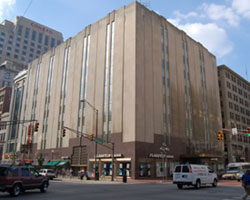
Wasson's Building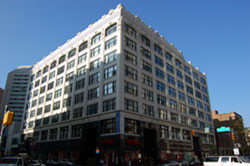
Block's Building - Marshall County
Plymouth was incorporated as a town, February, 1851, with a population of 600. The corporation was changed to a city in 1873 when the increase in population was sufficient. Levi and Meyer Lauer of Germany beginning peddling in the county in 1858. In 1861, they opened their first store, Lauer Brothers Clothing; they erect a new store in 1910. In 1990, Marshall County Historical Society acquired the Lauer Building for their museum.
There were as many as 35 families living in Plymouth, but no congregation was ever established. Jews went to larger cities like South Bend to worship. A Jewish section of Oak Hill Cemetery was consecrated in 1904. By the 1970s, very few families remained.
Plymouth was incorporated as a town, February, 1851, with a population of 600. The corporation was changed to a city in 1873 when the increase in population was sufficient. Levi and Meyer Lauer of Germany beginning peddling in the county in 1858. In 1861, they opened their first store, Lauer Brothers Clothing; they erect a new store in 1910. In 1990, Marshall County Historical Society acquired the Lauer Building for their museum.There were as many as 35 families living in Plymouth, but no congregation was ever established. Jews went to larger cities like South Bend to worship. A Jewish section of Oak Hill Cemetery was consecrated in 1904. By the 1970s, very few families remained.
- Miami County
Miami County, Indiana, located northeast of the state’s center along the banks of the Wabash River, was organized in 1834 on land purchased by Joseph Holman from the Miami Tribe of Chief, John B. Richardville, in 1830. The Miami moved from their historical home in Wisconsin to central Indiana over a century before Indiana Territory was established in 1800. But, they lost much of their land through a string of 1830s treaties, starting with the 1834 treaty which dissolved the Eel Creek Reserve and forced inhabitants to move to other land within Miami County. The federal government quickly purchased the newly-available land and started the Wabash-Erie Canal.
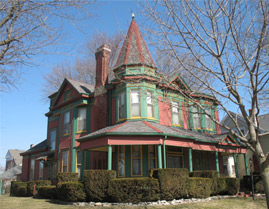
Moses Rosenthal House Peru, the county seat, was established shortly after Miami County, and became the hub of commercial and social activity in the county as those eager to work on the canal or sell goods to the canal workers trickled into the area. The first canal boat arrived in Peru in 1837. Additional treaties followed culminating in the 1840 treaty which forced the remaining Miami to cede their land and leave the state by 1845. This removal opened up Miami County for more development including the Lake and Western Reserve Railroad which reached Peru in 1854. Miami County’s first Jewish citizen was Moses Falk, an immigrant from Wurtemburg, Germany arrived in Miami County around 1838.
Read the entire document to learn about Peru’s Jewish Heritages.
- Monroe County
Bloomington is the county seat of Monroe County it was settled in 1815. Home to Indiana University, founded in 1820, it is one of the oldest institutions of higher learning west of the Alleghenies.
The first Jewish family to arrive in Bloomington was the brothers Isaac, Samuel and Levi Kahn, from France around 1855. Soon after their arrival, they opened their clothing business. In 1860 their nephew Moses joined the business. After serving as intern in the business with his uncles for several years, Moses joined Solomon Tannenbaum in business. In 1883 after a disastrous fire, Solomon Tannenbaum withdrew from the partnership. Moses paid back all creditors, reopened the business, and was one of the founding members of the Bloomington fire department. Moses died in 1920.
The Becovitz family came to Bloomington in 1893 from Poland. Abe opened a fruit store; Abe had moved by 1900. Two of his sons moved to Bedford, Indiana, opened a junk business. Later they opened a clothing store called Loubens. After an argument between the brothers, Loubens became Ben’s store, while Louis started the Vogue, an upscale women’s clothing store. Louis also opened an audio store called HiFi Specialists.
- Noble County
Noble County Jewish History A rumor may have enticed the first Jews to settle in Noble County, specifically Ligonier. In 1854 newspapers announced that the Lake Shore and Michigan Southern Railroad would pass through Ligonier, a village with 300 residents. Recent German immigrants Frederick William (F. W.) Straus and Solomon Mier recognized the potential economic opportunities a railroad offered and relocated to the small northern Indiana town from Fort Wayne or Auburn. Although the railroad company never installed a line through Ligonier, Straus and Mier indeed created and capitalized on multiple economic opportunities for themselves and their Jewish relatives.
- Porter County
Porter County Jewish History In 1836, Porter County was formed, including the territory now comprising both Porter and Lake Counties. French explorers, traders, and missionaries were the first Europeans to visit and live in the area with the Native Americans. In 1822, the first permanent white settler was Joseph Bailly. Valparaiso, the county seat, was originally platted as Porterville in 1836. Pennsylvania Railroad reached as far west as 1858 and many of the public buildings of the square were constructed in 1850.

Bodenheimer Bakery - St. Joseph County
St. Joseph County Jewish History Located in central northern Indiana along the Michigan border, St. Joseph County was established in 1830. Some of the county’s earliest residents operated trading posts, exchanging furs, maple sugar, and baskets. Later residents, most of them Jewish, opened formal stores and sold clothing and dry goods. These Jewish merchants immigrated from Germany and settled largely in the cities South Bend and Mishawaka. They ran businesses, built houses of worship, and bonded with each other and local German Christians through social clubs. In 1878 South Bend’s population included 125 individuals. By 1912 that figure had increased to 1,200, the third largest Jewish population in the state. A 1960 survey counted 805 Jewish households and 2652 individuals. This number declined throughout the 1970s as younger generations moved to larger cities. Nevertheless, the present local Jewish community, the remaining built environment, and documentary evidence serve as reminders of the rich St. Joseph County Jewish heritage.
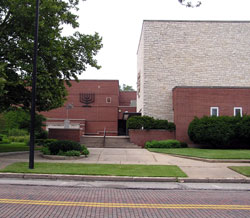
Temple Beth El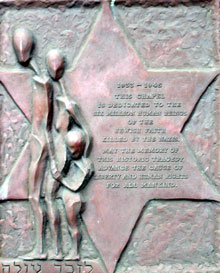
Dedication plaque, Jewish Memorial Chapel - Tippecanoe County
Tippecanoe County was organized in 1826. The city of Lafayette, was incorporated in 1853, is the county seat.
Ahvas Achim Congregation was formed in 1851. They had a school and cemetery, and by 1869 had built a temple by architect Jacob Welschbilling. The name was changed to Temple Israel in 1919. The congregation sold the building in 1969 and built in nearby West Lafayette. The original synagogue was listed in the National Register of Historic Places in 1977.
The city of Lafeyette has had a long history of Jewish business owners. Heintz Rosenwhitzengery was listed as a peddler in 1860. Samuel Bom was a grain dealer in 1869. Henry Rosenweig was a clothier in 1865; in 1875 he was also listed as a pawn broker. Leo Dreyfus was a butcher in 1869. He worked for Meyer and Kurtz. Charles and Daniel Kurtz were a butchers in 1869. Henry Strauss was a clothier in 1869. A. Strauss was a clothier in 1865. Emanuel Ullmann owned E. Ullman & Co in 1869. M. Ullmann owned a store that sold groceries and provisions in 1869.
- Vigo County
Vigo County Jewish History Terre Haute, is Indiana’s ninth largest city and the county seat for Vigo County. The first indication of permanent white occupation coincided with the construction of Fort Harrison in 1811, while the first record of a Jew in Terre Haute is 1827 when Samuel Judah (1798-1869) of Vincennes purchased land in the county. He descended from a family of Spanish Jews, who traveled to Canada, then New York before coming to Indiana. Judah later served in the Indiana House of Representatives from 1827 to 1829 and from 1837 to 1841, acting as Speaker in 1840-1841. From 1829 to 1833, he was U. S. Attorney in Indiana.

Temple B'nai Abraham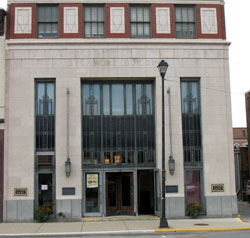
Sycamore Building - Wabash County
Wabash County Jewish History Wabash County, located in north-central Indiana was named for the Wabash River. Its largest city, Wabash, became the county seat in 1835. The area developed in response to the construction of the Wabash and Erie Canal, part of an ambitious state project to provide waterway transportation across Indiana. North Manchester, the second largest city in Wabash County, is home to Manchester College. From its founding through the turn of the nineteenth century, Jewish immigrants played an important role in shaping the history and development of Wabash County. Concentrated mostly within the city of Wabash, there was also a Jewish presence in North Manchester, with other families scattered throughout the county.
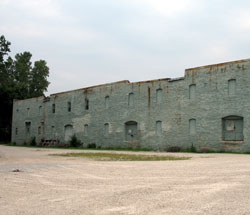
Wabash Canning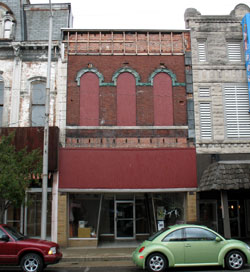
Simon Brothers Building - Wayne County
Wayne County Jewish History Richmond, Indiana (Wayne County) is particularly rich in Quaker history and is the home of Earlham College, founded by Quakers in 1847. Even before the establishment of this institution of high learning, the first Jew settled in the county. In 1834 William Brady, a harnesser and saddler, became the first permanent Jewish resident of Richmond; he died in 1872. He was not the only Jew living in the county, but at the moment is the only identified individual. Rabbi Isaac M. Wise, the leader in American Reform Judaism, reported in his German magazine, Die Deborah, on October 14, 1864, that there were Jewish families living in Richmond:
In the State of Indiana there is until now only one (synagogue) in Fort Wayne and a building planned for Evansville; however, communities are found in Indianapolis, Lafayette, and Terre Haute, many Jewish families reside in Vincennes, Logansport, and Richmond.
Over the next several decades, a variety of families from not just German, but also East Europe began arriving. The development of a community, rather than just individuals living in the same town began at a meeting sponsored by the American Jewish Relief Committee in 1919.
- Whitley County
Whitley County Jewish History Jews living in Whitley County during the nineteenth and twentieth centuries were a part of, not apart from, mainstream culture. According to one report one hundred Jewish individuals lived in the northeastern Indiana county in 1900. Most Whitley Jews resided in Columbia City, but a few families lived in South Whitley and one family lived in Churubusco. Possibly due to their small number, the local Jewish community did not erect a temple or synagogue, a Hebrew school, or kosher businesses. Rather, Whitley Jews befriended their non-Jewish neighbors, attended public schools, occasionally went to Christian Sunday school, and joined interfaith choirs. Yet through individual and group activities, the Whitley Jewry maintained their cultural heritage.
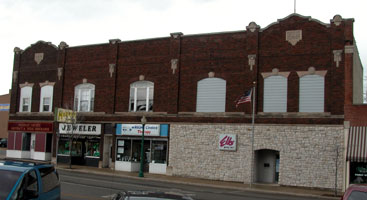
Chicago Fair Building, Columbia City
